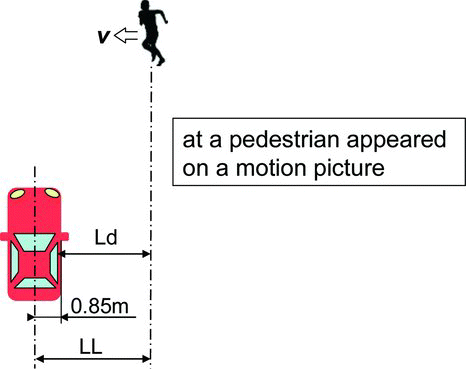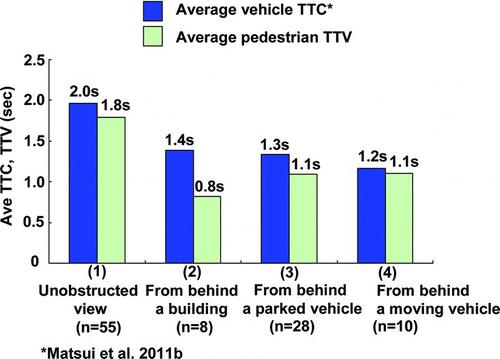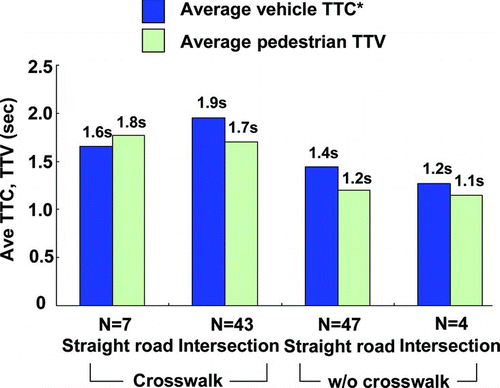Abstract
Objective: The objective of this study is to evaluate the severe conditions between car-to-pedestrian near-miss situations using pedestrian time-to-vehicle (pedestrian TTV) which is the time when the pedestrian would reach the forward moving car line.
Methods: Since the information available from the real-world accidents was limited, the authors focused on the near-miss situations captured by driving recorders installed in passenger cars. In their previous study, the authors found there were some similarities between accidents and near-miss incidents. It was made clear that the situations in pedestrians' accidents could be estimated from the near-miss incident data which included motion pictures capturing pedestrian behaviors. In their previous study, the vehicle time-to-collision (vehicle TTC) was investigated from the near-miss incident data. The authors analyzed data for 101 near-miss car-to-pedestrian incident events in which pedestrians were crossing the roads in front of a forward-moving car at an intersection or on a straight road. Using a video of near-miss car-to-pedestrian incidents captured by drive recorders and collected by the Society of Automotive Engineers of Japan (J-SAE) from 2005 to 2009, the pedestrian TTV was calculated. Based on the calculated pedestrian TTV, one of the severe conditions between car-to-pedestrian near-miss situations was evaluated for pedestrians who emerged from behind an obstruction such as a building, a parked vehicle and a moving vehicle.
Results: Focusing on the cases of the pedestrians who emerged from behind an obstruction, the averages of the vehicle TTC and pedestrian TTV were 1.31 and 1.05 seconds, respectively, and did not demonstrate a significant difference. Since the averages of the vehicle TTC and pedestrian TTV were similar, there would be a higher possibility of the contact between a car and pedestrian if the driver and pedestrian were not paying any attention.
Conclusions: The authors propose that a moving speed of a pedestrian surrogate “dummy” should be determined considering the near-miss incident situations for the evaluation of a CDMBS for pedestrian detection. The authors also propose that the time-to-collision of the dummy to the tested car during the evaluation of the performance of the CDMBS for pedestrian detection should be determined considering the time such as the vehicle TTC in this study. Additionally or alternatively, the pedestrian TTV should be considered, in which the worst situation was assumed for a car that was moving toward a pedestrian without braking due to the car driver's inattentiveness and the pedestrian not slowing down their walking speed or stopping.
Introduction
There were 4612 fatalities due to road accidents in Japan in 2011. Among these, pedestrians accounted for the highest number of fatalities (1686, or 37%; Institute for Traffic Accident Research and Data Analysis of Japan Citation2012). The Japanese government aims to reduce the number of annual fatalities to less than 2500 by 2018 (Japan Cabinet Office Citation2009). In particular, head injuries are the most common cause of pedestrian deaths in car-to-pedestrian accidents; thus, the Japanese Ministry of Land, Infrastructure, Transport and Tourism has begun assessing the safety performances of the bonnet tops of vehicles to reduce the contact force to the head (Matsui Citation2011). Furthermore, to decrease the severity of injuries and the number of deaths, active safety devices such as the collision damage mitigation braking system (CDMBS) for pedestrian detection using sensors is regarded as an effective countermeasure. Recently, cars equipped with the CDMBS for pedestrian detection utilizing a stereo camera sensor and with automatic braking installed (Kuzumaki Citation2009; Sekiguchi Citation2011; Shibata Citation2009) have been produced and sold in the Japanese market. The design including this system is expected to lower the vehicle velocity after cognition of a pedestrian in order to avoid a collision (Matsui, Han, and Mizuno Citation2011). If the contact situations in pedestrian accidents become clearer, the system can be enhanced to more fully address real-world accidents. However, the accident situations are not yet fully understood because detailed information on real-world accidents is limited. Previously, Rosen et al. (Citation2009) investigated the relative locations of pedestrians and cars 1 s prior to impacts that resulted in fatalities. However, there have been few other representative research studies. Hence, this study focused on near-miss incidents captured by drive recorders installed in passenger cars to research the contact situations.
The near-miss car-to-pedestrian incident is a situation in which a collision is avoided through the attention and braking of the driver. Near-miss incidents occur more frequently than accidents. Recently, drive recorders have been gradually installed in taxis in Japan to investigate the causes of car accidents and to educate drivers. The drive recorder data consist of video captured by a camera and the car's velocity, acceleration, and braking signal. If near-miss incidents have features similar to those of real-world accidents, then the car-to-pedestrian contact situations or the time to collision can be estimated from the near-miss incidents.
Table 1 Definition of vehicle TTC and pedestrian TTV
Matsui, Takahashi, et al. (Citation2011) investigated the similarities between the data on near-miss incidents and the data on national traffic accidents based on real-world fatal pedestrian accidents in Japan. Matsui, Takahashi, et al. (2011) found that 70 percent of pedestrians at intersections or on straight roads were crossing the roads in front of the forward-moving cars in both accident and near-miss incident. Thus, it is clear that one could estimate the situations encountered in pedestrian accidents from the near-miss incident data by utilizing the motion pictures capturing pedestrian behavior.
Matsui, Takahashi, et al. (Citation2011) also investigated the vehicle time to collision (vehicle TTC) from the 101 near-miss car-to-pedestrian incident data in which pedestrians were crossing the road in front of forward-moving cars at intersections or on straight roads. They calculated the vehicle TTC from the velocity of a car with an installed drive recorder and the distance between a car and a pedestrian at the moment a pedestrian appeared on a motion picture captured by the drive recorder (). It was observed that the vehicle TTC in cases where pedestrians emerged from behind an obstruction was shorter than that in cases where drivers had unobstructed views of the pedestrians when considering pedestrian behaviors. For example, the average vehicle TTC was the shortest (1.2 s) in cases where pedestrians emerged from behind moving vehicles in the opposite lane.
When the authors focused on pedestrian behavior in more detail, it was observed that a pedestrian had a walking speed laterally to the forward-moving car direction. Thus, the purpose of the present study is to evaluate the severe conditions between car-to-pedestrian near-miss situations using pedestrian time-to-vehicle (pedestrian TTV), which is the time when the pedestrian would reach the forward-moving car line (see ).
Materials
The Society of Automotive Engineers of Japan has collected near-miss incident data consisting of video recordings, car velocities, accelerations, and braking signals obtained from drive recorders installed in more than 100 taxis in Tokyo from 2005 (Nagai Citation2009). A drive recorder was installed on the inner side of the front window and consisted of a camera and triaxial accelerometers. The drive recorder was secured against the front window, with the angle of the camera fixed in a forward position. Videos were recorded at 30 frames per second. The near-miss data included data for the possible contact events of car-versus-car, car-to-pedestrian, car-to-bicycle, and car-to-motorcycle impacts.
The data collection was triggered by a driver's sudden braking at over 0.5 g deceleration, and the recorder captured data for 10 s before and 5 s after the triggering. The present study investigated the videos captured by drive recorders for 101 car–pedestrian near-miss incidents from 2005 to 2009 in which pedestrians were crossing the roads in front of the forward-moving cars at intersections or on straight roads; the videos were also used in a previous study (Matsui, Takahashi, et al. Citation2011).
Calculation of Pedestrian TTV
The pedestrian TTV (seconds) was calculated using EquationEq. (1), from the lateral distance between the pedestrian and car, Ld (m), and the pedestrian walking speed, v(m/s), at the moment that the pedestrian appeared in a video frame captured by the drive recorder, as shown in .
The lateral distance, Ld (m), between the pedestrian and the near side of the car was calculated using the following formula.
Tendency of Pedestrian Behavior in Near-Miss Incidents
To investigate car–pedestrian contact situations, the authors focused on visibility and pedestrian crosswalks. The authors measured the pedestrian TTV, the distance (Ld) between a pedestrian and a car, and the pedestrian walking speed in each of the above-mentioned situations to gain a detailed understanding of situations where a pedestrian and a car approached each other. Pedestrians crossing in a crosswalk were also investigated.
Effect of a Pedestrian Visibility
The authors divided the patterns of visibility of the pedestrians as they walked onto the road into 4 categories as presented in : (1) the driver had an unobstructed view of the pedestrian, (2) the pedestrian emerged from behind a building, (3) the pedestrian emerged from behind a parked vehicle, and (4) the pedestrian emerged from behind a moving vehicle.
Table 2 Four pedestrian patterns observed using drive recorders (color figure available online)
The average pedestrian TTV, the lateral distance between the pedestrian and car, and the pedestrian walking speed in the 4 classified pedestrian patterns are shown in . Looking at the average pedestrian TTV, (1) the unobstructed view was the longest, at 1.8 s, which was presumably due to the longer lateral distance (average 3.2 m). (2) From behind a building was the shortest, at 0.8 s, which was presumed to be due to the faster pedestrian walking speed (average 2.6 m/s). An average pedestrian TTV of 1.1 s was observed for both (3) from behind a parked vehicle and (4) from behind a moving vehicle.
Fig. 2 Average pedestrian TTV, lateral distance between a pedestrian and a car, and the pedestrian walking speed in 4 classified pedestrian patterns (color figure available online).
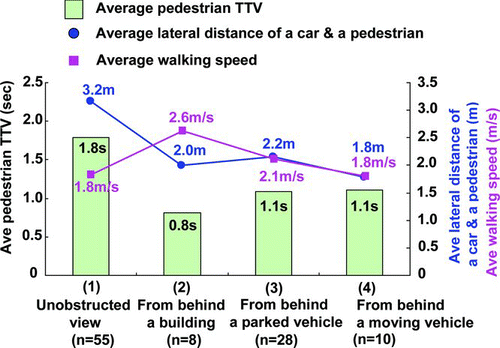
Averages for vehicle TTC that were previously obtained (Matsui, Takahashi, et al. Citation2011) and pedestrian TTV in 4 classified pedestrian patterns are shown in . The averages for vehicle TTC and pedestrian TTV were similar for the 4 classified pedestrian patterns.
Effect of a Pedestrian Crosswalk
The average pedestrian TTV, the lateral distance between a pedestrian and a car, and the pedestrian walking speed in 2 classified pedestrian locations (i.e., at a crosswalk or not at a crosswalk) are shown for straight roads and intersections in . When focusing on the existence of a crosswalk, it was observed that the average pedestrian TTV of 1.8 s on straight roads was similar to the average pedestrian TTV of 1.7 s at intersections. For the cases without a crosswalk, the average pedestrian TTV of 1.2 s on straight roads was similar to the average pedestrian TTV of 1.1 s at intersections.
Fig. 4 Average pedestrian TTV, lateral distance between a pedestrian and a car, and pedestrian walking speed on roads with or without a crosswalk (color figure available online).
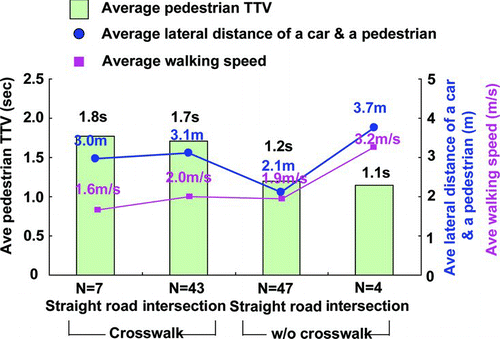
The averages for vehicle TTC that were previously obtained (Matsui, Takahashi, et al. Citation2011) and the pedestrian TTV on roads with or without a crosswalk are shown in . The averages for vehicle TTC and pedestrian TTV were similar on roads with and without a crosswalk.
Statistical Analysis for Detailed Features of Pedestrian Behavior in Near-Miss Incidents
To investigate car–pedestrian contact situations in more detail, the authors statistically investigated the effects of pedestrian visibility and pedestrian crosswalks. First, the authors divided the patterns of visibility of the pedestrians as they walked onto the road into 2 categories as presented in : (1) drivers had an unobstructed view of the pedestrian and (2) the pedestrian emerged from behind an obstruction, including a building or vehicle. Then, to investigate the effect of pedestrian visibility, the average pedestrian TTV, lateral distance between a pedestrian and a car, and the pedestrian walking speed were compared between (1) an unobstructed view and (2) an obstructed view of the pedestrian in order to analyze their significance.
Table 3 Two classifications of the visibility of pedestrians observed using drive recorders (color figure available online)
Second, the authors divided the patterns of near-miss situations into 2 categories for statistical analysis of the effect of a pedestrian crosswalk: (1) the pedestrian was using a crosswalk or (2) the pedestrian was not using a crosswalk. To investigate the effect of a pedestrian crosswalk, the average pedestrian TTV, the lateral distance between a pedestrian and a car, and the pedestrian walking speed were compared for cases of (1) pedestrians using a pedestrian crosswalk and (2) pedestrians not using a pedestrian crosswalk.
In the present study, the unpaired t-test was employed to compare the values of average pedestrian TTV, the lateral distance between a pedestrian and a car, and the pedestrian walking speed in each situation. The authors first examined the equality of variance among the two groups using an F-test. If the variances of the 2 groups were determined to be equal, Student's t-test was employed. If the variances of the 2 groups were determined not to be equal, Welch's t-test was employed.
Effect of a Pedestrian Visibility
The average pedestrian TTV, lateral distance between a pedestrian and a car, and the pedestrian walking speeds are given in for different pedestrian visibilities. The average pedestrian TTV and lateral distance between a pedestrian and a car in cases where drivers had an unobstructed view of pedestrians were significantly longer than those in which pedestrians emerged from behind an obstruction (P <.001 and.006, respectively). However, the average pedestrian walking speed in cases where drivers had unobstructed views of pedestrians was similar to that in the cases where pedestrians emerged from behind an obstruction (P = .090).
Table 4 Comparison of parameters for different pedestrian visibilities
Table 5 Comparison of parameters for the cases of pedestrians using or not using a pedestrian crosswalk
Effect of a Pedestrian Crosswalk
The average pedestrian TTV, the lateral distance between a pedestrian and a car, and the pedestrian walking speed for pedestrians using a pedestrian crosswalk or not using a pedestrian crosswalk are summarized in . The average pedestrian TTV and lateral distance between a pedestrian and a car were significantly longer in cases where pedestrians were using a pedestrian crosswalk (P = .013 and .047, respectively) than in cases where they were not. However, the average pedestrian walking speed in cases where pedestrians were using a pedestrian crosswalk was similar to that in cases where pedestrians were not using a pedestrian crosswalk (P = .577).
Discussion and Conclusions
Pedestrian walking speed was investigated in the present study, which focused on near-miss car-to-pedestrian incident data in which pedestrians were crossing the road in front of forward-moving cars. The average pedestrian walking speed was 2.0 m/s in the 101 near-miss incidents investigated in this article. Imanaka and Yasui (Citation2003) investigated pedestrian walking speeds on a crosswalk with a length of 22 m in front of a railway station in Tokyo during commuting hours and reported that the average walking speed of the 1444 pedestrians who walked to the station was 1.7 m/s. The National Traffic Safety and Environment Laboratory (Tokyo) investigated the normal walking speed of 28 persons who walked not on a crosswalk with a length of 7 m and the average walking speed was 1.2 m/s. These results indicate that the average walking speeds of pedestrians in the near-miss incident data were higher than those of pedestrians using a crosswalk during peak commuting hours or during normal walking. Thus, the authors propose that the moving speed of a pedestrian surrogate “dummy” should be determined considering the near-miss incidents for the evaluation of a collision damage mitigation braking system (CDMBS) for pedestrian detection. Moreover, the authors propose that the time to collision of the dummy with the tested car during evaluation of the performance of the CDMBS for pedestrian detection should be determined considering the time, such as the pedestrian TTV in the present study, and/or the vehicle TTC, which was evaluated in a previous study (Matsui, Takahashi, et al. Citation2011).
The authors calculated the pedestrian TTV from the walking speed of a pedestrian and the lateral distance between the pedestrian and the car at the moment when a pedestrian initially appeared in a video frame. The average pedestrian TTV of 101 car–pedestrian near-miss incidents was 1.5 s (SD 1.0 s). Focusing on the pedestrian patterns, the average pedestrian TTV (0.8 s) was the shortest in pattern (2), where pedestrian emerged from behind building. However, this classification had only 8 cases (). The authors found a significant difference in the pedestrian TTV between 2 groups: drivers who had an unobstructed view of pedestrians (n = 55) and pedestrians who emerged from behind an obstruction (n = 46). Matsui, Takahashi, et al. (Citation2011) investigated the vehicle TTC, which is the time of the vehicle arriving at the pedestrian location, so both vehicle TTC and the pedestrian TTV obtained in the present study are presented in . The authors compared the average vehicle TTC to the average pedestrian TTV in the 2 groups. When the view of the pedestrian was not obstructed, the average vehicle TTC and pedestrian TTV were 1.96 and 1.79 s, respectively, and were not significantly different (P = .510; see (1)). On the other hand, when pedestrians emerged from behind an obstruction, the average vehicle TTC and pedestrian TTV were 1.31 and 1.05 s, respectively, which was also not significant (P = .058; see (2)). These results demonstrated that the average vehicle TTCs and pedestrian TTVs were similar for these cases. Thus, in either condition for these 2 groups, it was estimated that there would be a high risk of a collision if both the driver and the pedestrian did not detect each other with the constant speeds of the car and pedestrian.
Table 6 Comparison of parameters for different pedestrian visibilities
When focusing on the pedestrian crosswalks and road circumstances (such as a straight road or intersection), it was observed that the average pedestrian TTV (1.1 s) was shortest when the pedestrian crossed an intersection without using a crosswalk, but this was evaluated with a limited number of cases (4 cases; see ). A significant difference was found in the pedestrian TTV between pedestrians using a pedestrian crosswalk (n = 50) and pedestrians not using a pedestrian crosswalk (n = 51), as shown in . Matsui, Takahashi, et al. (Citation2011) investigated the vehicle TTC, so both the vehicle TTC and pedestrian TTV obtained from this study are presented in . A comparison was made between the average vehicle TTC and the average pedestrian TTV for the 2 groups. When pedestrians used a pedestrian crosswalk, the average vehicle TTC and pedestrian TTV were 1.91 and 1.71 s, respectively, and were not significantly different (P = .495; see (1)). When pedestrians did not use a pedestrian crosswalk, the average vehicle TTC and pedestrian TTV were 1.43 and 1.19 s, respectively, which also was not significant (P = .118; see (2)). These results demostrate that the average vehicle TTCs and pedestrian TTVs were similar on these occasions. Thus, in either of the above 2 groups, it was estimated that there would be a high risk of collision if both the driver and pedestrian did not detect the other with the constant speeds of the car and pedestrian. The authors propose that this information should be incorporated in the specifications of the performance of the CDMBS for pedestrian detection using sensors. The authors also recommend that the newly obtained information should be reflected in the design of future safety devices considering the feasibility of the system.
Table 7 Comparison of parameters for cases of pedestrians using and not using a pedestrian crosswalk
Acknowledgments
The authors thank Assistant Professor Katsumi Moro, formerly at the Society of Automotive Engineers of Japan and currently with the Tokyo University of Agriculture and Technology, and Ryoko Imaizumi of the National Traffic Safety and Environment Laboratory Japan for their cooperation with the analysis of near-miss data.
© Yasuhiro Matsui, Masahito Hitosugi, Tsutomu Doi, Shoko Oikawa, Kunio Takahashi, and Kenichi Ando
References
- Imanaka , K and Yasui , K . 2003 . Research on Pedestrian Walking Speed and Behavior in Crosswalk [thesis] [in Japanese] , College of Science and Technology, Nihon University, Tokyo, Japan .
- Institute for Traffic Accident Research and Data Analysis of Japan . 2012 . Annual Traffic Accident Report in 2011 [in Japanese] , Tokyo, Japan: Institute for Traffic Accident Research and Data Analysis (ITARDA) .
- Japan Cabinet Office . 2009 . Current Traffic Accident Situation and Future Safety Countermeasure [in Japanese] , Tokyo, Japan: Cabinet Office, Government of Japan .
- Kuzumaki , S . 2009 . Our approach to a safe sustainable society [in Japanese] . J Soc Automot Eng Jpn. , 63 ( 12 ) : 11 – 19 .
- Matsui , Y . 2011 . Improvement of accelerometers for pedestrian headform impactors in testing following Japanese vehicle safety regulations . Int J Veh Saf. , 5 : 307 – 318 .
- Matsui , Y , Han , Y and Mizuno , K . 2011 . Performance of collision damage mitigation braking systems and their effects on human injury in the event of car-to-pedestrian accidents . Stapp Car Crash J. , 55 : 461 – 478 .
- Matsui , Y , Takahashi , K , Imaizumi , R and Ando , K . Car-to-pedestrian contact situations in near-miss incidents and real-world accidents in Japan . Paper presented at: 22nd International Technical Conference on the Enhanced Safety of Vehicles (ESV); June 13–16 , Washington , DC
- Nagai , M . Current situation in registration and application of drive recorder data base [in Japanese] . Paper presented at: Forum in JSAE Spring Convention in 2009 “What the Drive Recorder Can Contribute for Traffic Safety”; May 22 , Yokohama , , Japan
- Rosen , E , Kalhammer , J , Eriksson , D , Nentwich , M , Fredriksson , R and Smith , K . Pedestrian injury mitigation by autonomous braking . Paper presented at: 21st International Technical Conference on the Enhanced Safety of Vehicles (ESV); June 15–18 , Stuttgart , , Germany
- Sekiguchi , M . Introduction of SUBARU advanced driving system “EyeSight ver.2” [in Japanese] . Paper presented at: Safety Engineering Symposium 2011; July 7 , Tokyo , , Japan
- Shibata , E . 2009 . Development of driving assist system “EyeSight” by new stereo camera [in Japanese] . J Soc Automot Eng Jpn. , 63 ( 2 ) : 93 – 98 .
